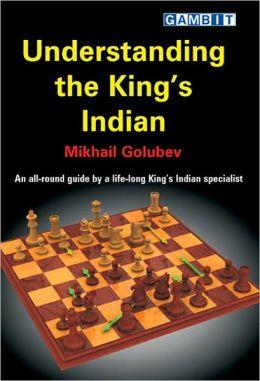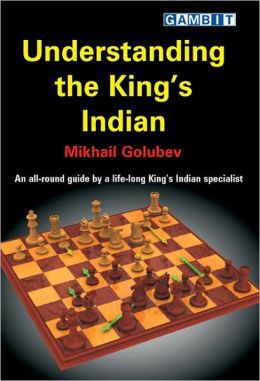
"Understanding the King's Indian" by Mikhail Golubev
 This week I will be reviewing another opening book - an excellent one about the King's Indian Defense - Understanding the King's Indian, by GM Mikhail Golubev. This book is for the most part meant for players of the black pieces. It includes 56 games, all played by the author, and covers all of the main systems that White uses against the King's Indian. It is not exactly a repertoire book, but it does recommend certain black responses to each of those systems, and is not encyclopedic in that it doesn't cover all of Black's other options.
This week I will be reviewing another opening book - an excellent one about the King's Indian Defense - Understanding the King's Indian, by GM Mikhail Golubev. This book is for the most part meant for players of the black pieces. It includes 56 games, all played by the author, and covers all of the main systems that White uses against the King's Indian. It is not exactly a repertoire book, but it does recommend certain black responses to each of those systems, and is not encyclopedic in that it doesn't cover all of Black's other options.
The book was published in 2006 and is one of the newer books on the King's Indian. Here is a rundown of the lines Golubev includes against the various White systems:
1) The Classical Variation - he focuses almost exclusively on the crazy - and theoretically critical - lines that begin with 7...Nc6. In the Gligoric Variation (7.Be3) he analyzes various Black responses.
2) The Makogonov Variation (6.h3) - he focuses on systems where Black plays ...e5.
3) The Suba Variation (5.h3 0-0 6.Bg5) - most games and analysis focus around lines where Black plays ...c5 at some point, instead of ...e5.
4) The Averbakh Variation - mostly 6...Na6, but there is one game with 6...c5 and another with 6...h6.
5) The Four Pawn Attack - 6...Na6 is the focus, but there is analysis of the main move 6...c5.
6) Saemisch - Almost all games and analysis are of the Panno Variation (...Nc6, ...a6, and ...Rb8) although there is one game featuring the 6...c5 pawn sacrifice.
7) The Fianchetto Variation - all games and analysis feature the classical way of meeting it, with ...Nbd7 and ...e5, in various permutation.
In many cases, if there is no game covering a certain black option, Golubev covers it in the notes. In particular, the less common white systems include analysis of various ways for Black to meet them.
I decided to cover another opening book because I believe this book has been pretty influential on me in recent years, and because I think it is a unique type of opening book. It is simultaneously an opening manual and a game collection which shows one grandmaster's practice in a particular opening; not well-known "good games" or brilliancies, but real, typical, and often quite ugly struggles in the opening which give the student a sense of what actually happens in average King's Indian Games. While the book is full of deep opening theory, it also conveys a sense of the spirit of the King's Indian.
Where I got it
I bought the book online in April 2009. Actually I didn't buy it, I used a gift certificate I got as a prize from the US tournament circuit Grand Prix.
I played the King's Indian a lot as a kid and when I was in college. Around 2001 I stopped playing it and turned to the Nimzo-Indian and Benoni, but I picked it up again in 2008 and it once again became one of my main openings.
What's good about it
First of all, the complete honesty of this book. Golubev is not trying to "sell" the opening. In fact, on the very first page of the book he says "The stakes are higher than in other openings and, basically, White gets some objective advantage from the very beginning". Throughout his analysis, if White has a better position or the line is dubious, he says that. You won't find a lot of "this (never played and weird-looking) move is interesting..." He looks for an objective evaluation of all the lines he covers.
Furthermore, the author is very modest. He presents many games he lost, including some rather ugly losses. He also makes many self-deprecating statements, and compliments his opponents. For example, in his game with Bareev from page 111, he wrote, "I must confess that, while analysing this game more than 20 years after it was played, I am more impressed with White's concept than I was immediately after the game, when I thought that I just lost an equal position by accident (maybe also because I tried to win it somehow)." At the end of the game he says, "An excellent performance by Bareev, who after the game complained that his opponent was unrated and therefore it would make little sense to send the game to Informator, etc. Now I am rated and am glad to help Evgeny to publish the game after all." Or, on page 123 after a game that he won he wrote, "In fairness to my opponent, a strong player (now a GM), it must be added that in Neuchatel two games per day were played, which often has a dramatic impact on the quality of the games."
Basically, I think that it is better to have a book written by someone who isn't going and trying to prove that he is the greatest, cherry-picking his best moments and leaving out the bad ones. This way you get a better view of reality. Also, I definitely have the sense that Golubev does not hide any "secret" analysis, or even do what some other writers have done - purposely recommend a line they know is bad in order to trick future opponents. It is naturally a problem with books written by strong players that they might leave out certain "secrets" - but Golubev appears to show everything he knows.
As Golubev points out in the introduction, he is not the world's strongest player of the King's Indian (he is a grandmaster around the 2500-2550 range). As he says "If most of the present King's Indian gurus (or Kasparov alone) were to reveal their secrets, I would possibly prefer to write not a book but a short article. In reality, however, the top players rarely show all what they know." Yet at the same time, Golubev is definitely strong enough to write a good book, and additionally is one of the top King's Indian experts, having played it almost constantly throughout his career.
I especially like the fact that the book includes entire games, which many opening books do not. It does not try to simplify anything, but shows it as it is. The fact that it includes only Golubev's games (as the main games) makes it rather unique in opening books. I think annotating one's own games is a good idea. You know better what happened in them than anyone else, and additionally you know everything that went into preparing for them, analyzing them afterwards, and the emotions and general feelings about the game at the time. It is very easy for an annotator, other than the player of the game, to present the game in such a way that bears no relation to what the players experienced during the game. There are no +/= type signs in the book - most of the game quotations include a verbal assessment of the position at the end. I also like the absense of comments such as "the computer says..."
How it impacted me
During 2009 and 2010 I was mostly playing in tournaments for my living, and was playing the King's Indian almost constantly. This is a book which I know pretty well, and I frequently brought it to tournaments to help with preparation (or more likely just to read when trying to fall asleep). While I always had a sense of the King's Indian being a world of its own, this book showed me more about that world. I frequently referred to it when working on the Mar del Plata variation (7...Nc6 in the Classical variation).
An Excerpt
It is pretty pointless for me to give as an excerpt a whole game including deep opening analysis. So I will show an example of commentary on one specific position. I am choosing one which contain more verbal description, because I don't really feel like copying down multiple long variations:
We are at the initial crossroad of what is probably the sharpest and most chaotic subsystem of the entire King's Indian.
As usual, White's main plan involves the c5 advance, with the eventual aim of crushing Black on the queenside. After c5, the opening of the c-file by cxd6 is White's basic idea, while c6!? can sometimes be dangerous as well.
The dark-squared bishop on f2 is extremely helpful in the attack: not only c5 but also b6 and a7 are sensitive squares. But there is also one difference that is disadvantageous for White compared to lines where he plays Nd3, f3 and Nf2: the bishop on f2 does not help to fight against the ...g4 advance. Therefore Black usually manages to prepare ...g4 at some stage. White can try to use the bishop as a defender with a regrouping by Kh1 and, after ...g3, Bg1. If Black's g3-pawn takes the white h2-pawn, then the black pawn itself may turn into a defender of the white king!
Black's most standard attacking plan begins with ...Ng6, ...Nf6, ...h5 (if there is no possibility to advance the g-pawn without this move!) and/or ...Rf7 (if the c7-square needs protection). At the moment, the knight is useful on d7 - from there it prevents White from advancing his c-pawn too easily. Once White has played Nd3 or b4, then the mission of the knight on d7 is accomplished and it can be moved to f6 without any misgivings.
Besides the main plan, Black has at his disposal another, more radical, idea: 13...Rf6!?, preparing an attack by ...Rh6 and ...Qe8-h5 or by ...Rg6, supporting g4. (page 18-19)
And here is an excerpt from the introduction:
How valuable is White's objective advantage in the King's Indian? The correct answer to this question is beyond our knowledge. There are grandmasters (even those who often use the King's Indian as Black), who have the opinion that with perfect play White should win. For my part, I firmly believe that Black, if he plays perfectly, should not lose. Some players, on the other hand, simply do not worry about such abstract theoretical questions.
A more practical question is: what does Black get in return for voluntarily giving his opponent an obvious (even if slight) opening advantage? In fact, he gets quite a lot. By playing the King's Indian, Black, as a rule, avoids early simplifications, which allows him to keep the position complicated (due, not least, to such a banal factor as the number of pieces remaining on the board!)
So, the King's Indian is a perfect opening choice for players who aim to 'outcalculate' the opponent in a complicated struggle. The spirit of the King's Indian was best described in my memory by one of its regular practitioners, Croatian GM Cvitan. "I want to be dangerous", he said during the post-mortem analysis of one of his games. (page 6)
Any Downsides?
As this book is closer to a repertoire book rather than an opening encyclopedia, you will not find certain lines which Black could choose analyzed. For example, there is practically no analysis of 7...Nbd7 in the Classical variation, and very little of 7...Na6. If you like to play a different variation other than the Panno against the Saemisch (such as 6...e5) then you will be disappointed. Similarly, if you play something other than ...Nbd7 and ...e5 against the Fianchetto variation, you won't find it here. Of course, this is due to the nature of the book - it couldn't be both a personal account and an encyclopedia at the same time.
While this book could certainly be useful for players of the white side, it is clearly geared towards black. Naturally, if you play white against the King's Indian, then you won't find all of black's possibilities covered here.
What you should eat/drink while reading this book
Fried lump crab cakes.






